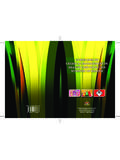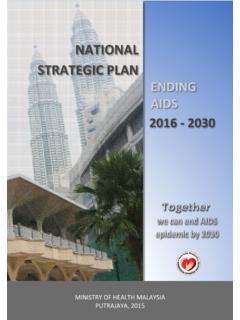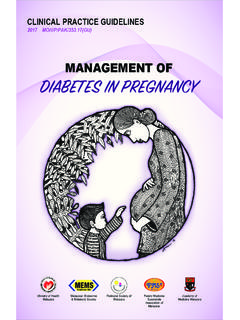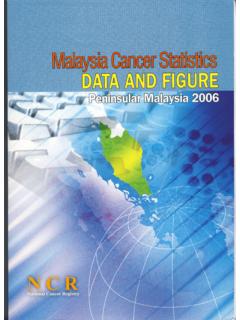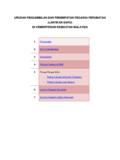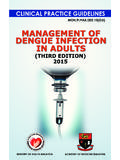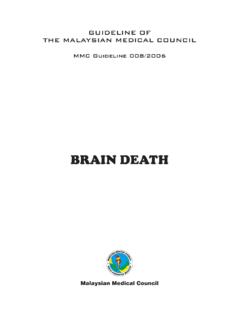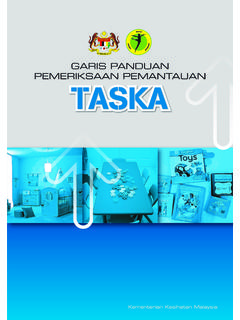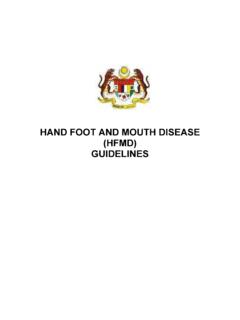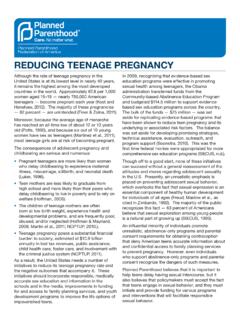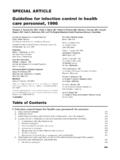Transcription of VTE - Ministry of Health
1 VTECLINICAL PRACTICE GUIDELINESP revention and Treatment ofVenous ThromboembolismMalaysian Society of HaematologyNational Heart Association of MalaysiaMinistry of Health MalaysiaAcademy of MedicineMalaysiaMOH/P/ (GU)STATEMENT OF INTENTT hese guidelines are meant to be a guide for clinical practice, based on the best available evidence at the time of development. Adherence to these guidelines may not necessarily ensure the best outcome in every case. Every Health care provider is responsible for the management options available OF THE GUIDELINEST hese guidelines were issued in 2013 and will be reviewed in 2017 or sooner if new evidence becomes version available on the following website: STATEMENTThe panel members had completed disclosure forms. None held shares in pharmaceutical firms or acted as consultants to such firms (details are available upon request from the CPG Secretariat).
2 SOURCES OF FUNDINGThe development of the CPG on Prevention and Treatment of Venous Thromboembolism was supported via unrestricted educational grant from Bayer Healthcare Pharmaceuticals. The funding body has not influenced the development of the 2013 Ministry of Health Malaysia019789671210000 ISBN 978-967-12100-0-002 GUIDELINES DEVELOPMENTThe development group for these guidelines consists of Haematologist, Cardiologist, Neurologist, Obstetrician & Gynaecologist, Vascular Surgeon, Orthopaedic Surgeon, Anaesthesiologist, Pharmacologist and Pharmacist from the Ministry of Health Malaysia, Ministry of Higher Education Malaysia and the Private search was carried out at the following electronic databases: International Health Technology Assessment website, PUBMED, MEDLINE, Cochrane Database of Systemic Reviews (CDSR), Journal full text via OVID search engine and Science Direct.
3 In addition, the reference lists of studies selected for inclusion were scanned for relevant clinical questions were divided into 18 subgroups and members of the development workgroup were assigned individual topics. Literature searched were appraised by workgroup members using Critical Appraisal Skills Programme (CASP) checklist, presented in the form of evidence table and discussed during group meetings. All statements and recommendations formulated were agreed by both the development group and review committee. Where the evidence was insufficient, the recommendations were derived by consensus of the development group and review articles were graded by using the national Guidelines Clearinghouse ( ), Agency for Healthcare Research and Quality, Department of Health & Human Services, USA, level of evidence while the grading of recommendations in these guidelines was modified from the Scottish Intercollegiate Guidelines Network (SIGN).
4 Refer to Appendix 12 for further guidelines have been presented to the Technical Advisory Committee for Clinical Practice Guidelines and the Health Technology Assessment and Clinical Practice Guidelines Council, Ministry of Health Malaysia for review and OBJECTIVESTo provide evidence based guidance in the management of venous OBJECTIVES! To provide guidance in preventing venous thromboembolism! To provide guidance in diagnosing venous thromboembolism! To provide guidance in treating venous thromboembolism! To provide guidance in anticoagulation and monitoring! To provide guidance in managing bleeding complications of anticoagulants! To provide guidance in managing VTE in special populations! To provide guidance in managing thrombosis in unusual sites! To provide guidance in perioperative management of anticoagulation! To provide guidance in establishing a Medication Therapy Adherence Clinic Warfarin(MTAC W)It is not the objective of these guidelines to cover:!
5 Management of arterial thrombosisTARGET POPULATIONAll patients with VTE or at risk for VTECLINICAL QUESTIONSR efer to appendix 13 TARGET GROUP/USERAll Health care professionals04 GUIDELINES DEVELOPMENT GROUPC hairpersonProfessor Dr Abdul Rashid Abdul RahmanConsultant Physician and Clinical PharmacologistCyberjaya Unviversity College of Medical Sciences and Hospital Pakar An NurCo ChairpersonDr Jameela SatharConsultant HaematologistAmpang Hospital Members (alphabetical order)Chong Chia Chee PharmacistAmpang Hospital Dr Eeson SinthamoneyConsultant Obstetrician & GynaecologistPantai Hospital Kuala LumpurDr Hamat Hamdi Che HassanConsultant CardiologistHospital Universiti Kebangsaan MalaysiaAssoc Professor Dr Hanafiah HarunarashidConsultant Vascular SurgeonHospital Universiti Kebangsaan MalaysiaDr Kiren SidhuConsultant Obstetrician & GynaecologistPantai Hospital Kuala LumpurAssoc Professor Dr Mohammad Hassan Shukur Consultant Orthopaedic and Trauma SurgeonHospital Universiti Kebangsaan MalaysiaDr Santhi Datuk PuvanarajahConsultant NeurologistHospital Kuala LumpurDr Shanti Rudra DevaConsultant Intensivist Hospital Kuala LumpurProfessor Dr Woo Yin LingConsultant Obstetrician & GynaecologistUniversity Malaya Medical Center05 REVIEW COMMITTEEThe draft of these guidelines are reviewed by a panel of independent expert referees from both
6 Public and private sectors, who were asked to comment primarily on the comprehensiveness and accuracy of interpretation of the evidence supporting the recommendations in the Dr Chang Kian MengHead of Haematology & Consultant HaematologistDepartment of HaematologyAmpang HospitalMembers (in alphabetical order)Dr Fitzgerald HenryHead of Surgery & Consultant SurgeonDepartment of SurgerySelayang HospitalDr Jay SuriarConsultant haematologistDepartment of HaematologyAmpang HospitalDr Kauthaman a/l MahendranHead of MedicineConsultant PhysicianDepartment of MedicineMalacca HospitalDr Liew Nyan ChinMedical Officer Department of Obstetrics & GynaecologyAmpang HospitalDr Muralitharan GanesalingamConsultant Obstetrics & Gynaecology Head of DepartmentDepartment of Obstetrics & GynaecologyAmpang HospitalDr Salmiah Md ShariffFamily Medicine SpecialistBatu 9, Cheras Health Clinic06Dr Shekhar KrishnanConsultant Paediatric HaematologistDepartment of PaediatricsUniversity Malaya Medical CenterDr Wan Hamilton bt Wan HassanHead and Consultant Obstetrician & GynaecologistDepartment of Obstetrics & GynaecologySerdang HospitalDr Wong Jun ChingMedical Officer Department of Obstetrics & GynaecologyAmpang HospitalDr Zaharah MusaHead of Radiology & Consultant RadiologistDepartment of Diagnostic ImagingHospital SelayangDr Zainal Ariffin AziziHead of Surgery & Consultant Vascular SurgeonDepartment of SurgeryHospital Kuala LumpurEXTERNAL REVIEWERSThe following external reviewers provided feedback on the Mike A LaffanProfessor of Haemostasis & ThrombosisDepartment of MedicineImperial College, United KingdomProfessor John Andrew MurieSenior Consultant Vascular Surgeon.
7 Royal Infirmary of EdinburghHonorary Senior Lecturer University of Edinburgh Medical SchoolAdjunct Professor, Universiti Kebangsaan MalaysiaProfessor Paul MonagleHead and Consultant Paediatric HaematologistDepartment of PaediatricsThe University of MelbourneRoyal Children s HospitalVictoria, Australia07 CLINICAL PATHWAYSPATHWAY 1: THROMBOPROPHYLAXIS1 Name of Assessor: Date:Thromboprophylaxis in HospitalisedPatientsMinistry of HealthMalaysiaNAME: DOB: SEX:HOSPITAL NO. IC Patient information2. Assess the risk for VTE and the risk for bleeding3. Risk factors for VTEv Assess all patients on admission to identify: t those who are at increased risk of VTE t those who are at increased risk of bleedingv Reassess patients risks of VTE and bleeding within 24 hours of admission and whenever the clinical situation changes v Weigh the risk of VTE against the risk of bleedingv Active cancer !
8 V Age >60 years !v Dehydration !v Critical care admission !v Obesity (BMI >30 kg/m2) !v Use of oestrogen containing oral contraceptive pill !v Use of Hormone Replacement Therapy !v Post partum (within 6 weeks) !v Previous VTE !v Family h/o VTE !v One or more significant medical comorbidities: " Heart disease !08 " Metabolic, endocrine or respiratory pathologies !#" Acute infectious disease !#" Inflammatory conditions !#" Sickle cell disease !#" Thalassaemia !v Varicose veins with phlebitis !v Active bleeding !v Acquired bleeding disorders (such as acute liver failure) !v Concurrent use of anticoagulants ( warfarin with INR > ) !v Lumbar puncture/epidural/spinal anaesthesia expected within the next 12 hours !v Lumbar puncture/epidural/spinal anaesthesia within the previous 4 hours !v Acute stroke !v Uncontrolled systolic hypertension (230/120 mmHg or higher) !
9 V Untreated inherited bleeding disorder ! ( haemophilia or von Willebrand disease)v Regard medical patients as being at increased risk of VTE if they: t have had or are expected to have significantly reduced mobility "" #$%"&'"()*+",- t are expected to have ongoing reduced mobility relative to their normal state AND t have one or more of the risk factors for VTEv Regard surgical patients and patients with trauma as being at increased risk of VTE if they meet one of the following criteria: t Surgical procedure with a total anaesthetic and surgical time of >90 minutes, or 60 minutes if the surgery involves the pelvis or lower limb t Acute surgical admission with inflammatory or intra abdominal condition t Expected significant reduction in mobility t One or more of the risk factors for VTE4. Risk factors for bleeding5. Hospitalised Patients at increased Risk for VTEM edical patientsSurgical & trauma patients096.
10 Methods for VTE prophylaxisA. Mechanical Anti embolism stockings (thigh or knee length) v Base the choice of mechanical VTE prophylaxis on individual patient factors including clinical condition, surgical procedure, patient preference and if bleeding risk outweighs the risk of VTEv Choose any one of:#" Anti embolism stockings !#" Foot impulse devices !#" Intermittent pneumatic compression devices !v Do not offer anti embolism stockings to patients who have:#" Suspected or proven peripheral artery disease#" Peripheral arterial bypass grafting#" Peripheral neuropathy#" Any local conditions in which stockings may cause damage dermatitis, gangrene, recent skin graft " Known allergy to material#" Cardiac failure#" Severe leg oedema#" Unusual leg size#" Major limb deformityv Use stockings that provide graduated compression and produce a calf pressure of 14 15 mmHgv Encourage patients to wear their stockings day and night until they no longer have significantly reduced mobilityv Remove stockings daily for hygiene purposes and to inspect skinv Encourage patient to use foot devices both in bed and when sitting in a chairFoot impulse devices v Encourage patient to use IPC devices for as much time as possible both in bed and when sitting in a chairIntermittent pneumatic compression devices (thigh or knee length) v Base the choice of pharmacological VTE agents on individual patient factors, including clinical condition and patient preferencesB.
